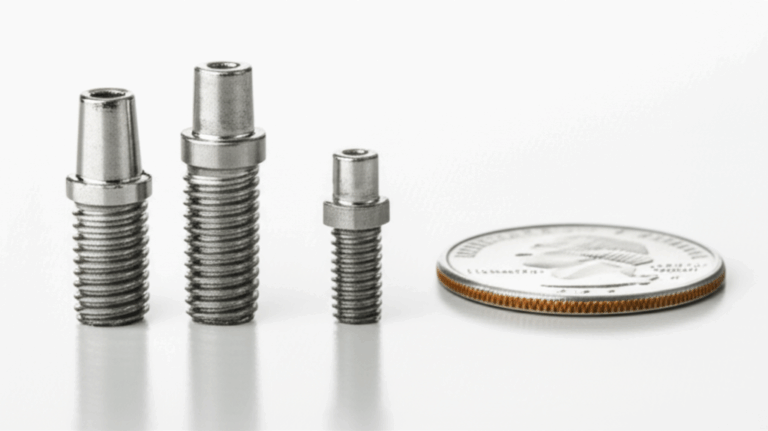
What Are Dental Implants, Really? A Complete, Compassionate Guide for Everyday People
That missing tooth in your smile might feel like a big deal—whether it’s up front or in the back. You may have found yourself not wanting to laugh, skipping some foods, or getting nervous about what comes next. “What are dental implants, really? How do they work, and could they be right for me?” If you’ve thought any of these things, you’re in the right place.
Losing a tooth (or even more than one) happens to millions of people every year. But today, thanks to good dental care, you have more ways than ever to get your bite and your confidence back. Dental implants—those tiny, strong posts that act like new tooth roots—have changed everything. But reading through all the details can feel like too much. This guide sorts it all out in plain English, so you can decide what’s right for you.
In This Article
- What Exactly Is a Dental Implant?
- Why Would Someone Need a Dental Implant?
- How Do Dental Implants Work? (The Simple Science)
- Are Dental Implants Safe? What About Pain?
- Are You a Good Candidate for Implants?
- What Are the Pros and Cons? (Your Options Explained)
- The Steps of Getting a Dental Implant—From Start to Finish
- Caring for Your Implant: What to Expect Long-Term
- Your Most Common Questions—Answered!
- Key Takeaways & Your Next Steps
What Exactly Is a Dental Implant?
Let’s make this clear. When your dentist talks about an implant, they’re not talking about a cover that sits on your tooth, or a denture you take out each night. A dental implant is a tiny post—usually made from titanium or ceramic. The dentist puts it where your missing tooth’s root was. Think of it as a solid anchor, holding your new tooth steady in your jaw.
On top of the post, your dentist puts a connector (called an “abutment”) and then a special crown. This crown looks and works a lot like a real tooth. Lose more than one tooth? Several implants can hold a bridge or even a whole fresh set of teeth.
In Simple Terms:
- Dental Implant = Fake Root
- Abutment = Connecting Part
- Crown = The “Tooth” Part
It’s a bit like building a fence post—first you dig the post in deep, then you add the parts you see. A dental implant is like that, only much smaller and friendlier!
Why Would Someone Need a Dental Implant?
You may wonder, “Why do people get implants? Why not fill the gap with something else?” These are good questions.
Common reasons for needing an implant:
- Accidents and Injuries: A fall, playing sports, or biting down wrong can knock out a tooth.
- Bad Cavities or Infection: Sometimes, a tooth can’t be saved—not even with a root canal or filling.
- Gum Disease: Bad gum problems sometimes mean a tooth has to go.
- Born Without a Tooth: Some people never grow certain adult teeth.
What if you just leave the gap? Sadly, missing a tooth often leads to:
- Trouble Chewing and Talking
- Teeth Shifting or Tilting
- Jawbone Getting Smaller Over Time
- Your Face or Smile Changing
- Feeling Less Confident
An implant isn’t just about looks. It keeps your bite working, your jaw healthy, and lets you enjoy your favorite foods.
How Do Dental Implants Work? (The Simple Science)
Let’s keep the science easy.
Your teeth are sort of like icebergs—what you can see is small compared to what’s below the surface. The roots hold each tooth in your jawbone. When you lose a tooth, your bone senses the missing pressure and starts to get smaller. That’s why some people notice their face looking a bit “sunken” after losing teeth.
A dental implant is a replacement root. Here’s how:
Step 1: The Implant
A special post (usually titanium, since it works well with your bone) goes into your jaw. In a few months, your bone actually grows around the post—a process called “osseointegration.” It’s like a big, strong hug from your body!
Step 2: The Abutment
When the implant is solid, your dentist puts on the abutment. This joins the hidden post to your new tooth.
Step 3: The Crown
Last, a custom-made crown (sometimes made at a special implant dental laboratory) goes on top. This is shaped and colored to look like a real tooth so it matches your smile.
In Other Words:
A dental implant isn’t just a plug—it acts as a real tooth root, built to handle all the biting, chewing, and talking you do every day.
Are Dental Implants Safe? What About Pain?
It’s normal to worry about safety—and pain, too! Hearing “implant surgery” might sound scary. But let’s be real.
Dental implants are one of the most tested treatments in dentistry. They work well (more than 95% succeed) and have been done for many years. If an expert does the work, they’re very safe.
What About Pain?
- During the procedure: You’ll get numbing medicine, so you shouldn’t feel pain—just some pressure or odd feelings.
- After: Expect a bit of soreness, swelling, or even slight bruising. Most people do fine with simple pain pills and are back at their normal stuff in a day or two.
- Later on: Once you heal, implants feel just like real teeth. No sharp edges or sliding around.
Every surgery has some risks. Infections, nerve issues, or an implant not “taking” can happen, though it’s rare. Pick a good clinic and follow care steps closely.
Are You a Good Candidate for Implants?
You might wonder, “Is this for me? What if I’ve lost bone, or have health issues?” Here’s a simple breakdown.
Good Candidates Usually:
- Are missing one or more teeth
- Have a fully grown jaw (usually over 18)
- Have healthy gums, or at least no bad gum disease untreated
- Are healthy overall (illnesses like uncontrolled diabetes can slow healing)
- Do not smoke, or are ready to stop for the process
What If My Jawbone Is Weak?
Don’t lose hope! In the past, less bone meant no implants. These days, treatments like bone grafts or “sinus lifts” can help get your jaw ready. Your dentist will take X-rays or scans to check.
Who Might Not Be a Candidate?
- Folks with certain ongoing health problems (like hard-to-control diabetes, blood issues)
- Heavy smokers who won’t quit
- People having radiation near their jaw
- Those with severe bone loss that can’t be fixed
Short answer: Only a dental checkup can tell you for sure. Treat it like your “Smile Plan” session!
What Are the Pros and Cons? (Your Options Explained)
One answer doesn’t fit all. Here’s a simple look at your choices—plus the good and the bad of implants, dentures, and bridges.
Dental Implants
Pros:
- Feel and look like real teeth
- May last many years, sometimes for life
- Stop bone getting smaller and help save other teeth
- Don’t move around or slide when eating or talking
- Clean with regular brushing and flossing
Cons:
- Cost more in the beginning than some other things
- Need a small surgery and some months to heal
- Sometimes need extra things like a bone graft
- Not always paid for by insurance
Dentures (Take Out Full or Partial)
Pros:
- Can replace many or all teeth quickly
- Usually cost less
- No surgery needed
Cons:
- Can slip, click, or feel big in your mouth
- Might make eating or talking harder at the start
- Won’t stop jawbone shrinking away
- Have to be taken out and cleaned each night
Fixed Bridges
Pros:
- They don’t come out—stuck in place
- Faster than implants (no healing wait)
- Cost less
Cons:
- Often means filing down healthy teeth on each side
- If one tooth goes bad, the whole bridge might fail
- Won’t keep your jaw solid
Good Questions to Ask:
- Do I want the most real-feeling and real-looking option?
- Am I okay with a small surgery?
- What’s my plan to pay—right now and down the line?
- How good am I at keeping my teeth clean?
The Steps of Getting a Dental Implant—From Start to Finish
Knowing what happens next can calm worries. Here’s how it usually works:
1. First Visit & Planning
Your dentist does a careful check—looks at your teeth, maybe X-rays or special scans—to make a plan just for you. They’ll check your jaw and gums and answer your questions.
2. Implant Surgery
Sounds scary, but most people say it’s a lot like having a filling or a tooth pulled. You’ll be numb. The implant post is gently placed in your jaw.
3. Healing Time (3–6 Months)
This is when your bone grabs onto the post. (Don’t worry—your dentist can give you a temporary tooth so you can still smile.)
4. Abutment Time
A quick, easy step where the connector is attached.
5. Crown Goes On
At last! Your new crown, made just for you (sometimes made in a crown and bridge lab), is set in place.
6. Checkups and Care
You’ll come back a couple times to make sure all is well.
Caring for Your Implant: What to Expect Long-Term
Implants are easy to care for, but not totally “set it and forget it.” Think of them as top-quality things that need good treatment!
Simple Steps:
- Brush and Floss Every Day: Just like you would with normal teeth—usually nothing fancy needed.
- Go for Regular Dental Visits: Keep up your cleanings and have things checked.
- Don’t Do Bad Stuff: Don’t open things with your teeth. If you clench or grind, ask your dentist about a night guard dental lab mouthpiece.
- Watch For Trouble: Any pain, swelling, or looseness? Call your dentist soon.
Extra Tip: Implants can’t get cavities, but your gum and jaw still need your care. Staying healthy helps your whole mouth!
Your Most Common Questions—Answered!
Q: How long will my implant last?
A: With good care, many last over 20 years. Some people keep them for life!
Q: Will people see it’s not a real tooth?
A: Not unless you tell them! Each one is made to match your real teeth.
Q: How much do dental implants cost?
A: They cost more up front than bridges or dentures, but can save money later since you might not need other fixes. Costs change based on where you are and your needs—ask your dentist for a price just for you.
Q: What might go wrong?
A: All medical work has some chance for problems, but these are rare. Things like infection, nerve trouble, or a failed implant happen less than 5% of the time.
Q: Will my body reject the metal?
A: Being allergic to titanium is super rare. If needed, ceramic implants are out there for those few with a real allergy.
Q: Can I get an implant if I smoke?
A: It’s best to quit. Smoking makes healing and success much harder.
Q: What if I lose more teeth later?
A: Implants can hold single teeth or even bridges/full sets, so there are choices if your needs change.
Key Takeaways & Your Next Steps
Let’s make it simple:
- Dental implants are strong, real-looking fake teeth roots.
- They keep your jaw healthy, save your smile, and help you feel good about yourself.
- Most healthy adults can get them. Even if your jaw is weak, today’s treatments may help.
- Other options (like dentures and bridges) are out there—with their own ups and downs.
- The process takes a few months but is worth it for most people.
- Taking care is easy: brush, floss, see your dentist.
Want to learn more?
If you’re thinking about dental implants, book a visit with your dentist or implant expert. You’ll get answers built around your mouth and your life.
Want info about other dental fixes, like veneers or night guards? Read our plain-language articles on dental problems and the real benefits of modern veneers. When you know more, you can make the best choices for your mouth!
Remember: Your smile is yours—treasure it and take care of it. Dental implants are just one way (for lots of folks, the best way) to get your smile back. Whatever you pick, just getting started is always the biggest and best first step.
References & Resources
- American Dental Association. “Implants.” MouthHealthy.org.
- Mayo Clinic. “Dental implants: Surgery and Risks.”
- International Congress of Oral Implantologists, “Frequently Asked Questions.”
- National Institutes of Health, “Dental Implants in Older Adults.”
Keep asking questions—they matter!








